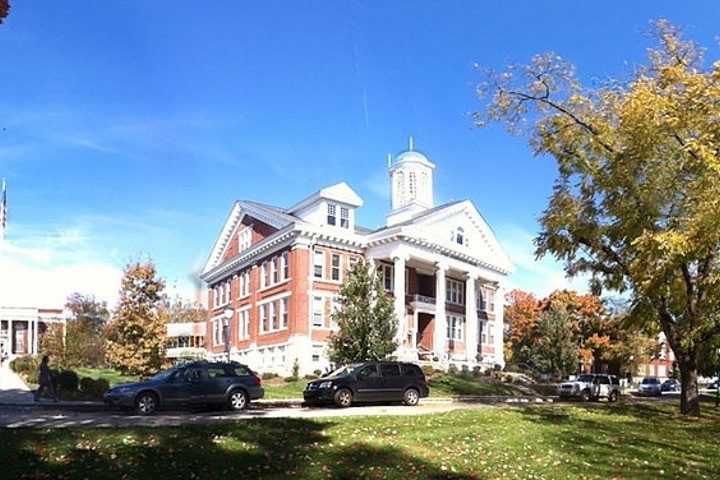
The surprise revival at a small private Christian university in Kentucky is spreading like wildfire across the country and around the world. Videos posted on YouTube by participants are being viewed by hundreds of thousands, and two days ago the hashtag #asburyrevival had 24 million views on TikTok. Traffic is pouring in to Wilmore, Kentucky, where the school is located, and people from as far away as Canada and New Jersey are attending the surprising event.
Asbury University has about 2,000 students all told, including grad students. Part of the curriculum requires attendance at chapel on Wednesday mornings. On Wednesday, February 8, it was all routine — until it wasn’t.
Alexandra “Lexie” Presta, executive editor of the on-campus paper The Asbury Collegian, couldn’t believe what was happening:
I have been in Hughes Auditorium for almost twelve hours now without an intent to leave anytime soon.…
As a senior, I have never witnessed anything like this.
I’ve heard about it from alumni, especially those who have come to chapel and spoken about their experience with the [Asbury] Revival of 1970….
It doesn’t seem like the night is planning to end anytime soon.…
The Collegian will provide updates….
That was on Wednesday night. On Sunday night the revival continued, and Lexie was there, providing the promised update:
We’ve been here in Hughes Auditorium for over a hundred hours — praying, crying, worshipping and uniting — because of Love.
We’ve even expanded into Estes Chapel across the street at Asbury Theological Seminary and beyond.
Students and their parents are making the trip to Wilmore, including students from Georgetown University, Indiana Wesleyan University, Ohio State, Purdue, and the University of Kentucky, along with students from two dozen other smaller colleges.
And the wildfire is spreading onto those campuses as well. One of them, Lee University in Cleveland, Tennessee, is experiencing a similar revival. Rob Fultz, Lee University’s campus pastor who attended the Asbury revival, tweeted: “A mighty move of God started this morning [February 13] at Lee and has been building throughout the day. We are approaching the 10th hour, nothing but voices in prayer, worship, and repentance.”
Laura Levens, a journalist from Baptist News Global, reported on what she saw happening at Asbury:
On the floor and in the balcony, there were all ages of people. Seniors in college sitting in front of senior citizens. Families with multiple children, rows of teenagers, babies, men in their early thirties, college athletes — and so many of these people were singing.
They sang widely used praise and worship songs, as old as Jesus Culture and as recent as Hillsong, with a few hymns important to the Asbury students mixed in.
Thomas McCall, a professor of theology at Asbury, witnessed the revival with initial skepticism:
As an analytic theologian, I am weary of hype and very wary of manipulation. I come from a background (in a particularly revivalist segment of the Methodist-holiness tradition) where I’ve seen efforts to manufacture “revivals” and “movements of the Spirit” that were sometimes not only hollow but also harmful.
I do not want anything to do with that.
And truth be told, this is nothing like that. There is no pressure or hype. There is no manipulation. There is no high-pitched emotional fervor.
To the contrary, it has so far been mostly calm and serene. The mix of hope and joy and peace is indescribably strong and indeed almost palpable — a vivid and incredibly powerful sense of shalom.
McCall described what he saw from the very beginning:
Most Wednesday mornings at Asbury University are like any other. A few minutes before 10, students begin to gather in Hughes Auditorium for chapel. Students are required to attend a certain number of chapels each semester, so they tend to show up as a matter of routine.
But this past Wednesday [February 8] was different. After the benediction, the gospel choir began to sing a final chorus — and then something began to happen that defies easy description.
Students did not leave. They were struck by what seemed to be a quiet but powerful sense of transcendence, and they did not want to go. They stayed and continued to worship. They are still there.…
They were still worshiping when I left in the late afternoon and when I came back in the evening. They were still worshiping when I arrived early Thursday morning — and by midmorning hundreds were filling the auditorium again. I have seen multiple students running toward the chapel each day.
By Thursday evening, there was standing room only….
The worship continued throughout the day on Friday and indeed all through the night.
On Saturday morning, I had a hard time finding a seat; by evening the building was packed beyond capacity. Every night, some students and others have stayed in the chapel to pray through the night. And as of Sunday evening [February 12], the momentum shows no signs of slowing down.
News of the revival finally caught the attention of the secular media. Yesterday a reporter from NBC News was assigned the task of investigating the event in Wilmore. He couldn’t believe what he saw:
Tuesday night [February 14] capped the largest crowd yet: 3,000 worshipers piled into the college chapel and four [other] facilities throughout the college town.
At least two-thirds of the attendees are from out of state.…
Students and staff from 22 schools have visited so far, alongside groups from Hawaii to Massachusetts.… Travelers from Singapore and Canada are expected to arrive soon.
The Asbury College Revival of 1970 lasted 185 hours, and some historians compared it to America’s Great Awakenings of 1740 and 1800. The Lexington Herald Leader recounted that event:
Students were required to attend chapel services three times a week.
Asbury, in Wilmore, a city of 4,300 about 16 miles south of Lexington, is an interdenominational religious college whose roots are in the Wesleyan tradition of the Methodist church. (John and Charles Wesley, brothers, were 18th-century revivalists.)
On that Tuesday morning in 1970, Custer Reynolds, Asbury’s academic dean and a Methodist layman, was in charge. President Dennis Kinlaw was traveling. Reynolds did not preach. Instead, he briefly gave his testimony, then issued an invitation for students to talk about their own Christian experiences.
There was nothing particularly unusual about that.
One student responded to his offer. Then another. Then another.
“Then they started pouring to the altar,” Reynolds said. “It just broke.”
Gradually, inexplicably, students and faculty members alike found themselves quietly praying, weeping, singing. They sought out others to whom they had done wrong deeds and asked for forgiveness.
The chapel service went on and on. Asbury, like many evangelical organizations, held annual, scheduled “revivals,” with guest ministers and services booked in advance.
This, however, was not the same. No one had planned it. No one was leading it. “There was just a different feeling about that day,” said Marilyn Blackburn, who was then a junior at the college. She is now a substitute schoolteacher in New Jersey.
People didn’t want to leave, she said. They were afraid they would miss something wonderful.
It is said that for believers no explanation for this is necessary. For unbelievers, no explanation is possible. On February 23, just over two weeks from the beginning of this revival, the Luke 18 Project will be holding its Collegiate Day of Prayer. More than 1,200 campus ministries, churches, and individuals have already signed up to participate.
And where is that Collegiate Day of Prayer scheduled to take place? Asbury University in Wilmore, Kentucky.



